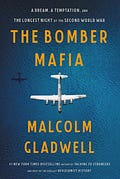Review and highlights: The Bomber Mafia, by Malcom Gladwell
Malcom Gladwell is commonly criticized for reaching some inaccurate conclusions. In “The Tipping Point,” he popularized the Broken Window Theory, which states New York City’s tight policing of minor infractions drove historic crime decreases in the 90s and early 2000s. In fact, that decrease began before the city’s efforts. Gladwell’s detractors blame him popularizing the tactics throughout the US, leading to increased harassment of underprivileged Americans.
But Gladwell is master storyteller who examines historical topics in an engaging way. It’s on the reader to draw their own conclusions and, if so inclined, do further research with other sources.
Through that lens, “The Bomber Mafia” is another interesting and important work by Gladwell.
The Bomber Mafia was born as a audiobook, and then later converted to print. It’s a bit on the short side, coming in under 180 pages. As a result, it feels somewhat incomplete, more like a lengthy blog post than a full-length book. Given the gravity of the material, Gladwell could have presented a more complete story by including more perspectives of the German and Japanese citizens who suffered at the hands of the Allies’ all-out bombing efforts.
Key ideas from The Bomber Mafia
General Haywood Hansell was the leader of The Bomber Mafia, a small group within the military that believed an emerging technology—airborne warfare—could make wars shorter and far less deadly. By dropping bombs with precision onto strategic targets, Hansell believed wars could be won faster and with far less bloodshed.
Unfortunately, Hansell’s theory failed in the field. The technology was not there to bomb with precision. The weather wrecked havoc on their efforts. And, because precisions runs had to occur during the daytime, missions were more susceptible to both enemy pilots and groundfire.
General Curtis LeMay had a competing vision. He too believed airpower could shorten wars, but only by bombing widely and indiscriminately to create as much civilian and military destruction as possible. After successfully revamping and leading the bombing efforts over Germany—including going on bombing runs himself—LeMay replaced Hansell in the Pacific. As a result, the U.S. firebombed nearly 70 Japanese cities using napalm, and, of course, dropped atomic bombs on Hiroshima and Nagasaki.
Gladwell examines the motivations of both men and reaches a couple of interesting conclusions. LeMay, reviled in some circles for his aggressive tactics, probably did shorten the war, and undoubtably saved the lives of many Allied soldiers who would have died in a ground invasion of Japan. LeMay’s vision that short and brutal war creates faster peace might have been the right one overall.
But in the long run, Hansell and The Bomber Mafia’s vision won out. Technology simply had to catch up. Today, the United States can drop a missile into a particular room of a house from a drone. Pinpoint bombing is a reality.


